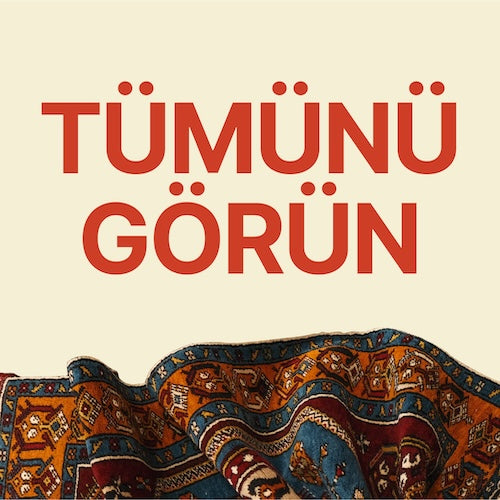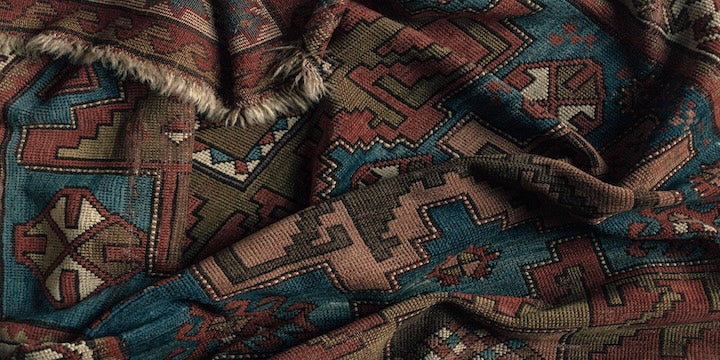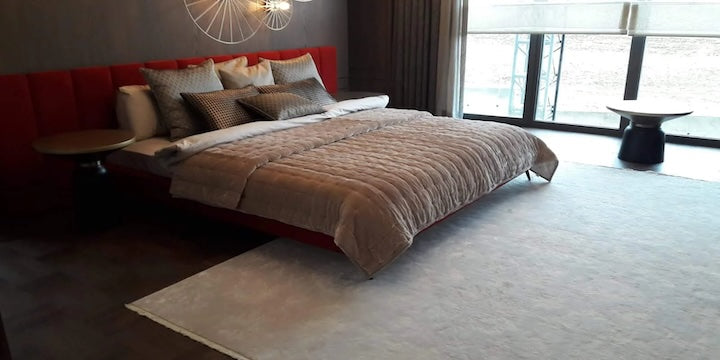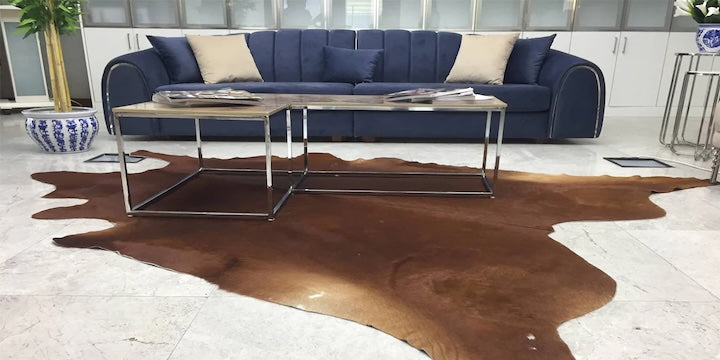Beginning in the steppes of Asia existence Turkish communities, whose journey continues all over the world today, have quite rich mythological narratives, although they are not as famous as Greek and Roman mythology. The origins of these narratives, most of which are included in oral culture, can be found in various Chinese sources and archaeological studies. Undoubtedly, the places where these narratives find their true expression Turkish carpet ve Turkish rug.
Carpet weaving has a very unique position in terms of its prevalence and history among Turkish handicrafts. Turkish carpet weaving, which is one of the first weaving traditions that come to mind when it comes to authentic carpets in the world, tells the history of Turks and Turkish culture that stretches over centuries and many geographies through Turkish carpet and kilim motifs. This simple, strong and plain expression creates this universal aspect of our weaving.
It can be said that what makes Turkish rugs and carpets unique is not only the weaving technique, but also that it reflects the hopes, prayers, past and future expectations of the weaving in each stitch.
The roots of these stories and emotions, which are processed in a thread by thread, can be found in the nomadic Turkish communities, which live together with the sometimes quite difficult, sometimes unusual and fertile aspects of nature. Besides the herds of animals on which their lives depend, and the tents they make their homes, these communities migrate wherever they migrate. carpet and rug looms they have also taken.
Turkish carpets and kilims have been known and sought after all over the world with their durability, unique color preferences and aesthetic aspects since then.
Meanings of Carpet Rug Motifs
Turkish carpet and kilim motifs It is as diverse as the geographies where the Turks are dispersed, and as rich as their stories and myths.
Mythological narratives are a great legacy that connects us to our ancestors, describing the common lives of people for centuries, our similar questions and problems in life with the mastery of imagination. This week on the Halıcızade Blog, I will share with you, whose source is mythology. Turkish carpet motifs we wanted to share.
Child Motif:
Since the earliest examples we have come across, the child motif has been Turkish carpet motifs It is one of the most common uses of the human figure. It is thought that its origin is based on the Mother Goddess narrative in Turkish mythology. Not only in Turkish mythology, but also in many mythologies, the child is the symbol of pure life energy, innocence and fertility. Representing the moon in the sky in Turkish mythology and the goddess of waters and seas, Ak Ana is depicted as a woman of eternal light and tells Ülgen to create humans. Turkish carpet art This fertility call of Ak Ana is embroidered on carpets and kilims with a child motif.
Deer Pattern:
The figure of the deer is a motif strongly traced in many cultures, from distant Asia to Scandinavia and America. In Turkish mythology, the deer motif represents the spirit of nature, which gives life to human beings, the wisdom and power of rule that the Turks received from their ancestors. It is one of the motifs that best expresses the old Turks' view of nature. In ancient Turkish beliefs, game animals are not a sign of people's superiority over nature, on the contrary, they are a blessing that deserves the highest level of respect that nature offers to people. Because Turkish carpet motifs Among the deer, the deer is one of the powerful symbols of the transmission of the power given by nature as a spirit from generation to generation. Many Turkish states attribute the source of the authority they receive from the god to deer totems.

Eagle and Bird Motif:
All of the 24 Oghuz tribes believed to be the ancestors of the Anatolian Turks base their origins on a bird totem. These bird motifs have also been symbols of tribes. Among the bird motifs that we encounter in various weavings, one of the most prominent ones since the 1300s is the eagle motif. Since the Anatolian Seljuk state chose the double-headed eagle figure (Öksökö), which is actually a symbol of Turkish mythology, as the symbol of the state, since the carpets that date back to this state, carpet motifs The use of the eagle is becoming more and more common. The eagle motif symbolizes power, strength, ability to rule, and fairness to those who govern.


Dragon Motif:
The dragon is a mythical animal that we encounter frequently, especially in Asian culture. With their depictions reminiscent of reptiles and various dinosaur species, dragons begin their lives underground, after completing their development, they rise to the sky and fly above the clouds. It is they who enable plants to grow and grasslands to green. For the nomadic Turks, who were engaged in animal husbandry, the growth and greening of plants was of vital importance. So much so that it was the gradual decrease of the pastures that feed the animals that caused the world history to undergo a radical change by initiating the migration of tribes. From this point of view, it is not surprising that the animal that turns the wheel of the sky, causing time to flow and history to change, is the dragon. Carpet motifs and their meanings Among them, the dragon is an important symbol that points to the reason for the existence of the nomads. It represents fertility by making it rain, nature to be respected and sometimes feared by causing drought.


Tree of Life Motif:
The tree of life symbol is a common symbol in almost all cultures of the world. It is found in all cultures with similar meanings. For Turkish communities, who took their nature consciousness and respect for nature from their nomadic ancestors, the tree is a living creature that carries a soul within it and that needs to be respected and protected. It is believed that a tree that is cut down while it is still alive will offend the spirit of the tree and cause various disasters. Dry trees collected for burning or processing are also treated with gratitude and respect. For this reason, the Turks chose the tree of life as a symbol to describe their "life journey" and carpet motif used as. The tree of life symbolizes being born as a part of nature, living with respect to nature, and finally returning to nature by dying.


Scorpion Motif:
One of the biggest problems of the nomadic Turks in their settlements was the poisonous scorpions. Thanks to these motifs embroidered on the borders and outer edges of the rug or carpet, people believed that they would protect themselves from scorpions. Besides being a real threat, Scorpio is also a symbol of anything that threatens the household from the outside.
Earring Pattern:
This earring pattern embroidered on carpets and rugs was mostly made by single young girls. The meaning of this pattern is to indirectly tell the family that the girl weaving the rug or carpet wants to get married.
Eagle Motif:
We see the eagle symbol, which has a very important place in Turkish history, in Turkish rugs and carpets. This motif represents power, might, and being "with a state", that is, being fortunate.
Coach Horn Motif:
The ram's horn motif represents productivity, management and masculinity. It can reflect the feelings of the weaver, or it can be woven as a well-wisher.
Amulet Motif:
The amulet pattern is embroidered in a triangle on the carpet or rug. It is thought that this motif will protect the owner of the carpet or rug from trouble.
Bukağı Motif:
This motif symbolizes unity and togetherness. Bukağı motif is also embroidered as a wish for the embroiderer to meet with the person he hopes to meet.
Chest Pattern:
This pattern also represents the dowry chest of young girls who have reached the age of marriage. This pattern, which is woven into a rug or carpet, is also a method of saying "my dowry is complete, I am ready for marriage".
Hand, Finger and Comb Motifs:
The finger pattern indicates that the weaver is protected from evil eyes, the comb motif indicates fertility, and the hand motif indicates fertility and abundance.
Plus and Hook Motifs:
As in many cultures, it represents the four aspects, the 4 basic principles of life and the 4 elements. In other words, it can be said that it is a symbol of vitality and commitment to life.
Hand on Waist Motif:
It symbolizes pattern, femininity and motherhood. Productivity and abundance are also symbolized by these motifs.
Eye Pattern:
For the eye pattern, mostly blue yarn is chosen. Just like the evil eye bead, it is believed to prevent the evil eye and curse.
Fertility Motif:
The dot in the middle of this pattern sombolizes the family, while the horn-like parts in the margins represent the mates. With horn-like parts, the message that the family in the middle is protected and guarded is given.
Star Pattern:
The star symbol expresses the reflection of God in man in many cultures. It has also been used in Turkish culture to represent the abilities that God has bestowed on man.
Waterway Pattern:
How important water is in human life is not reflected in Turkish carpet and rug motifs. The woven waterway patterns symbolize dynamism, vitality and life.
Hair Tie Motif:
Hair tie is a sign of the desire to marry and establish a home. The symbol woven as hair symbolizes immortality. It touches the wishes of the lovers to reunite and stay together forever.







1 comment
Leave a comment
This site is protected by hCaptcha and the hCaptcha Privacy Policy and Terms of Service apply.